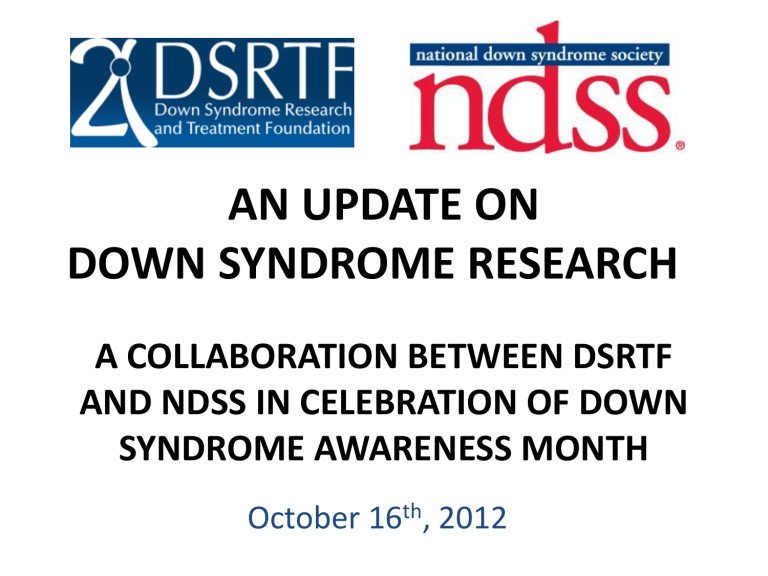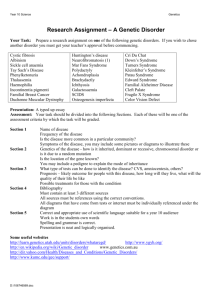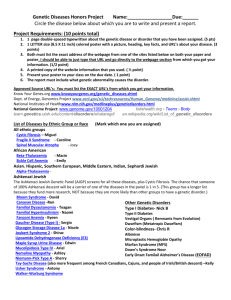Webinar Slides - National Down Syndrome Society

AN UPDATE ON
DOWN SYNDROME RESEARCH
A COLLABORATION BETWEEN DSRTF
AND NDSS IN CELEBRATION OF DOWN
SYNDROME AWARENESS MONTH
October 16 th , 2012
The Status of Cognition Research in Down Syndrome: Agenda
• Patty White, DSRTF Co-Founder: DSRTF’s mission, strategy and accomplishments
• Dr. Roger Reeves, Ph.D. Johns Hopkins Univ. School of
Medicine: The Status of DS Cognition Research
• Sara Weir: NDSS VP of Advocacy and Affiliate Relations:
NDSS advocacy initiatives and accomplishments
• Q & A
Down Syndrome Research &
Treatment Foundation’s Mission
• Stimulate and fund cognition research to improve learning, memory, and speech for individuals with Down syndrome
• Translation of research to deliver treatments to allow individuals to:
• Participate more successfully in school
• Lead more active and independent lives
• Prevent or delay early cognitive decline
Why Cognition Research?
• Cognitive challenges present throughout life
• Generally, mild to moderate cognitive impairment
• Significant presence of neuropathology of
Alzheimer ’ s disease by the age of 40
DSRTF Strategy
FOCUS
Pioneer in stimulating cognition research
RESOURCES
Leaders in funding and executing Ds-specific research strategy
COLLABORATION
Interdisciplinary coordination and communication
TRANSLATION
Accelerate the move from research to treatments
2003 Down syndrome Research
•
•
•
•
No evidence of what causes impaired cognition in people with Down syndrome
No targets on which to focus efforts
Minimal government funding
Few researchers focused on DS cognition
Research Advances
• Link between genes and cognitive ability
• Areas of the brain that work differently ” mechanisms ”
• Continued growth in number of candidate treatments
• Two clinical trials
Government Funding: NIH Per Capita Investment
52X
39X
2X
3X
5X
6X
13X
27X
28X
400,000 1,500,000 400,000 1,500,000 400,000 45,000 17,500 30,000 30,000 30,000
Number of Individuals affected in the U.S
.
Translational Research in Down Syndrome
Roger H. Reeves, Ph.D.
Dept. of Physiology
McKusick-Nathans Institute for Genetic Medicine
Johns Hopkins University School of Medicine rreeves@jhmi.edu
This work was supported by NICHD and NCI under PHS award 3R01-HD0038384. NHLBI supports identification of genetic modifiers of Congenital Heart Disease in Down syndrome under award HL83330. The Down Syndrome Research and Treatment Foundation ( DSRTF ) and Research Down Syndrome ( RDS ) support assessment of the ameliorative effects of SAG on trisomic brain development. The Anna and John Sie Foundation supported establishment of the DS Cognitive test battery. Dr. Reeves is a consultant for Hoffman-LaRoche Inc. and
Elan Pharmaceuticals .
072412
What do we know for sure about Down Syndrome?
Reeves, R.H.
2000. Nature
405:283-284.
Comparative mapping
Genes on human Chr
21 are found on Chr
16, 17 and 10 in mouse
Ts65Dn
(karyotype by Gail Stetten, Sarah South)
Muriel Davisson
Can a mouse have Down syndrome?
A.
Short stature *
{
Flat facies *
Flat nasal bridge *
Protruding tongue *
Highly arched palate ( * )
Mental retardation,
“DS type” *
Small cerebellum *
4. Mental retardation,
“DS type”
Ts65Dn mice are significantly deficient in functions that require the hippocampus, like the Morris water maze test.
Reeves, R.H., N.G. Irving, T. Moran, A. Wohn, C. Kitt, S. Sisodia, C. Schmidt, R.T. Bronson and M.T. Davisson. 1995.
A mouse model for Down Syndrome exhibits learning and behavior deficits. Nature Genetics 11:177-184.
The Down syndrome (trisomic) brain: functional outcomes
•
Hippocampal function is robustly affected in mouse DS
models (Ts65Dn, Ts1Cje)
Reeves et al., Nat. Gen. 1995; Escorihuela, Neuro Lett. 1995; Holtzman et al., PNAS 1996
J Neurodevel Disorders 2010
ACTB, Targeted Brain Regions
• Cerebellum
– Tested core function(s): motor responsiveness, reaction times
• Prefrontal cortex
– Tested core function(s): Holding of information in active or working memory to guide action selection; executive function
• Hippocampus
– Tested core function(s): Storage of episodic information in longterm memory
Research Design
(U. Wisconsin: Oregon Health Science
Univ.,;Children’s Nat’l. Medical Center;
M.I.N.D. Institute, UC Davis; Children’s
Hospital of Philadelphia)
J Neurodevel Disord (2010) 2:149-164
M.I.N.D.
Institute
Understanding the variability of cognition among individuals with Down syndrome
Oregon Health &
Sciences University
Nevada
Idaho
Currently 9 sites in the DSRTF network
Waisman Center
Children’s
Hospital of
Philadelphia
North Dakota
Montana
Minnesota
New
Wisconsin
South Dakota
Wyoming
Utah
Arizona
Colorado
New Mexico
Nebraska
Kansas
Oklahoma
Iowa
Pennsylvania
Ohio
Illinois Indiana
West
Virginia
Virginia
Missouri
Kentucky
North Carolina
Tennessee
Arkansas
Mississippi Alabama
South Carolina
Georgia
Texas
Louisiana
University of Arizona
Johns Hopkins
University
Kennedy
Krieger Inst.
Children’s
National Medical
Center
Emory
University
0
0
Haw aii
The Down syndrome (trisomic) brain: functional outcomes
Neuropharm 36: 1549, 1997
J Neurosci 2004
Fernandez et al., Nat Neurosci., published online Feb 25 2007
Experimental Protocol: Assessing the Cognitive
Effects of Pentylenetetrazole in Ts65Dn Mice
Day 1 and 2: Home
Cage Feeding
Time
Day 3 and 4:
Milk Intake in
Feeding
Tubes
Day 5 thru 21:
Drug
Administration in
Feeding Tubes
Test
Day 14
Test
Day 21
Pentylenetetrazole Treated Ts65Dn Mice Exhibit
Improved Object Recognition Memory
Short term evaluation at the end of 2 wks. of treatment
40
30
20
10
0
Milk
*
WT
Ts65Dn
PTZ
Fernandez et al., Nat Neurosci., 2007
Pentylenetetrazole given to Young Adult Mice
Causes a Lasting Improvement in Circuit
Functionality ( 2-3 months )
Dentate LTP
170
160
150
140
130
120
110
100 wt
Ts65 + PTZ
Ts65Dn ctrl.
0 10 20 30
Time (min)
40 50 60
Fernandez et al., Nat Neurosci., 2007
http://www.roche-trials.com/ trialDetailsGet.action?studyNumber=BP25543/
Mouse clinical trial results:
1.
Genetic models of trisomy 21 show features of DS
2.
Hippocampal function is especially affected
3.
Excessive inhibitory input to hippocampus results in reduced LTP and specific behavioral outcomes
4.
Treatment with drugs that antagonize GABA-ergic transmission (antagonists, inverse agonists) normalize physiological and behavioral outcomes in mice
Mouse clinical trial results:
1.
Genetic models of trisomy 21 show features of DS
2.
Hippocampal function is especially affected
3.
Excessive inhibitory input to hippocampus results in reduced LTP and specific behavioral outcomes
4.
Treatment with drugs that antagonize GABA-ergic transmission (antagonists, inverse agonists) normalize
physiological and behavioral outcomes in mice
Will drug therapy affect adaptive behaviour in people with DS? And if so, how will we know?
Transformative research support from DSRTF and NDSS
1.
Next generation of drug therapy for cognition: PTZ, L-DOPS, SAG; high throughput drug screening in model systems
2.
Sleep: Sleep patterns in mice, sleep studies in people, how does the disruption of sleep patterns contribute to cognitive effects in Down syndrome;
3.
Behavioral neuroscience: New outcomes measures for clinical trials, measures for children, tests for language acquisition
4.
Alzheimer Disease: Why is risk elevated in DS? How can we treat it? What does this tell us about treating the AD pandemic?
5.
FUNDING: Foundation support is critical, but NIH provides the bedrock and with a shrinking NIH budget, this has become increasingly political. NDSS has put much significant into working with law makers to influence policies and funding. http://www.dsrtf.org/page.aspx?pid=357#9
Current challenges:
Genetic associations/ Co-morbidities
GWAS/
CNV
Define phenotypes.
Genome wide genetic analysis.
Co-morbidities.
Basic research that relies substantially on mouse models has changed the game for people with
Down syndrome.
It appears that there is an important role for models of DS and AD in understanding both conditions.
Reeves lab
Donna Klinedinst
Huiqing Li
Annan Yang
Ishita Das
Sarah Edie
Duane Currier
Sarah Edie
Renita Polk
Tara Howard
Ben Devenney
Cognition
Lynn Nadel
Jamie Edgin
Stephanie Sherman
SAG
Paul Worley
Meifang Xiang
Joo-Min Park
Hoon Shin (NIH)
Craniofacial
Joan T. Richtsmeier
Clinical trial, Hopkins/KKI
Julie Hoover-Fong
George Capone
Willie DeLeon
Josh Ewan
Carrie Blout
Lisa Toole
Families, families, families
NDSS Legislative Agenda
• The legislative and policy priorities span the life experience of individuals with Down syndrome from birth through adulthood and range in issue from healthcare to asset development
• These priorities have been shaped by self-advocates, families, affiliate leaders and others under the direction of the NDSS
Board of Directors and the
National Governmental
Affairs Committee (NGAC)
Creating an
Economic Future for Individuals with Ds
Improving Health
Outcomes and
Quality of Life for
People with Ds
Increasing
Opportunities for
Adults with Ds
Improving
Education
Opportunities for
People with Ds
31
What does the NDSS Policy Center do?
Works with Congress and federal agencies to develop and improve laws, regulations and other policies
Trains and educates parents, selfadvocates and others to advocate on the local, state and national levels
Organizes and participates in coalitions of national disability organizations
Leads national DS advocacy program
32
What is NDSS working now?
• Congressional Momentum Around Down Syndrome Research Funding & Priorities
– Annual appropriations for NIH to advance the research priorities for Down syndrome
– Current annual funding for Down syndrome at NIH is $22 million
– 2012-2013 budget outlook /Sequestration
• Advocating for the passage of the Trisomy 21 Research Act Package
– A package of legislation aimed at strengthening the research infrastructure for Down syndrome and improving the translational research opportunities for Down syndrome
• Trisomy 21 Research Resource Act of 2011
• Trisomy 21 Research Centers of Excellence Act of 2011
• Collaborate with Leadership at National Institutes of Health (NIH) and Eunice
Kennedy Shriver National Institute for Child Health & Human Development (NICHD)
– Participate in the NIH Down Syndrome Consortium
– National Down Syndrome Research Plan – Request for Information Opportunity
– New National Down Syndrome Patient Registry
• New National Plan to Address Alzheimer’s Disease at HHS
– The US Department of Health & Human Services (HHS) published the Plan, which underscores the relationship between Down syndrome and Alzheimer’s disease
– NDSS is work with HHS to engage a new taskforce on addressing the unique care challenges faced by people with younger-onset Alzheimer's disease, and improve access to long-term services and supports for younger people, including those with Down syndrome
How Can You Get Involved in
Advocacy?
• Join NDSS Online
– Follow NDSS on Facebook, Twitter, Pinterest
– Subscribe to our NDSS e-newsletter
– Subscribe to our NDSS Advocacy Alerts
You can do all this by visiting www.ndss.org
• Become a NDSS DS-Ambassador Program
– Join the over 100+ DS-Ambassadors from across the country
– NDSS DS-Ambassadors are volunteers committed to taking part in the democratic process and serve as liaisons between NDSS and their Congressional Delegations
• Attend the annual NDSS Buddy Walk® on
Washington
– 2013 Buddy Walk on Washington will be March 13-14th
– Buddy Walk on Washington is our annual two-day advocacy conference that brings the Down syndrome community together to advocate for legislative priorities that impact the lives of people with Down syndrome and their families
– You can register for the Buddy Walk on Washington at www.ndss.org.
34







